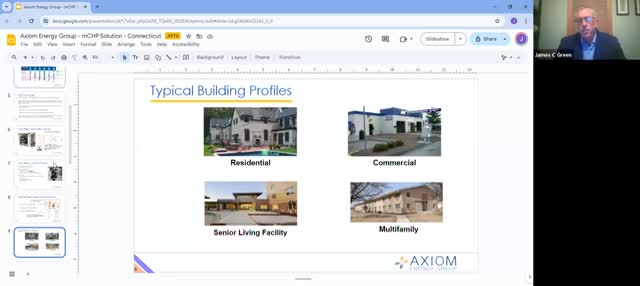Innovative system slashes energy costs and boosts efficiency
October 15, 2024 | New Canaan, Fairfield, Connecticut
This article was created by AI summarizing key points discussed. AI makes mistakes, so for full details and context, please refer to the video of the full meeting. Please report any errors so we can fix them. Report an error »

A recent government meeting highlighted the innovative energy system implemented in a multifamily building in South Milwaukee, which has demonstrated significant efficiency in both electricity and gas consumption. The system, designed to heat water at night and supply it during the day, has shown remarkable results even during the summer months, countering the common belief that such systems are only effective in colder climates.
Presenters shared utility bills illustrating that after the installation of the system in January, the building began producing more electricity than it consumed, achieving a negative consumption of 600 kilowatts per month. This shift not only reduced reliance on the grid but also contributed to grid resilience. In contrast, prior to the system's installation, the building's electricity consumption ranged from 1,500 to 2,000 kilowatts monthly during the summer.
The system's efficiency stems from its continuous operation, which allows it to produce hot water consistently, even when occupancy levels fluctuate. During colder months, lower occupancy led to reduced hot water demand, resulting in less electricity generation. However, the summer months saw full occupancy, enabling the system to operate nearly around the clock, thus maximizing electricity production.
Additionally, the system has led to a notable decrease in gas consumption, with average daily therms dropping from 18.1 to 14.4 in July and from 19 to 13 in August. This efficiency is attributed to the system's design, which maintains a steady production of thermal energy, contrasting with traditional water heaters that operate intermittently and require higher energy inputs.
The building owner also considered solar energy solutions but found that the costs associated with installing sufficient solar panels would exceed the investment in the current system. Moreover, solar panels would not address the gas consumption issue, as traditional water heaters would still be required to meet hot water demands.
Overall, the meeting underscored the potential of this energy system as a viable alternative to traditional heating methods, showcasing its ability to enhance energy efficiency and reduce costs in multifamily housing.
Presenters shared utility bills illustrating that after the installation of the system in January, the building began producing more electricity than it consumed, achieving a negative consumption of 600 kilowatts per month. This shift not only reduced reliance on the grid but also contributed to grid resilience. In contrast, prior to the system's installation, the building's electricity consumption ranged from 1,500 to 2,000 kilowatts monthly during the summer.
The system's efficiency stems from its continuous operation, which allows it to produce hot water consistently, even when occupancy levels fluctuate. During colder months, lower occupancy led to reduced hot water demand, resulting in less electricity generation. However, the summer months saw full occupancy, enabling the system to operate nearly around the clock, thus maximizing electricity production.
Additionally, the system has led to a notable decrease in gas consumption, with average daily therms dropping from 18.1 to 14.4 in July and from 19 to 13 in August. This efficiency is attributed to the system's design, which maintains a steady production of thermal energy, contrasting with traditional water heaters that operate intermittently and require higher energy inputs.
The building owner also considered solar energy solutions but found that the costs associated with installing sufficient solar panels would exceed the investment in the current system. Moreover, solar panels would not address the gas consumption issue, as traditional water heaters would still be required to meet hot water demands.
Overall, the meeting underscored the potential of this energy system as a viable alternative to traditional heating methods, showcasing its ability to enhance energy efficiency and reduce costs in multifamily housing.
View full meeting
This article is based on a recent meeting—watch the full video and explore the complete transcript for deeper insights into the discussion.
View full meeting
